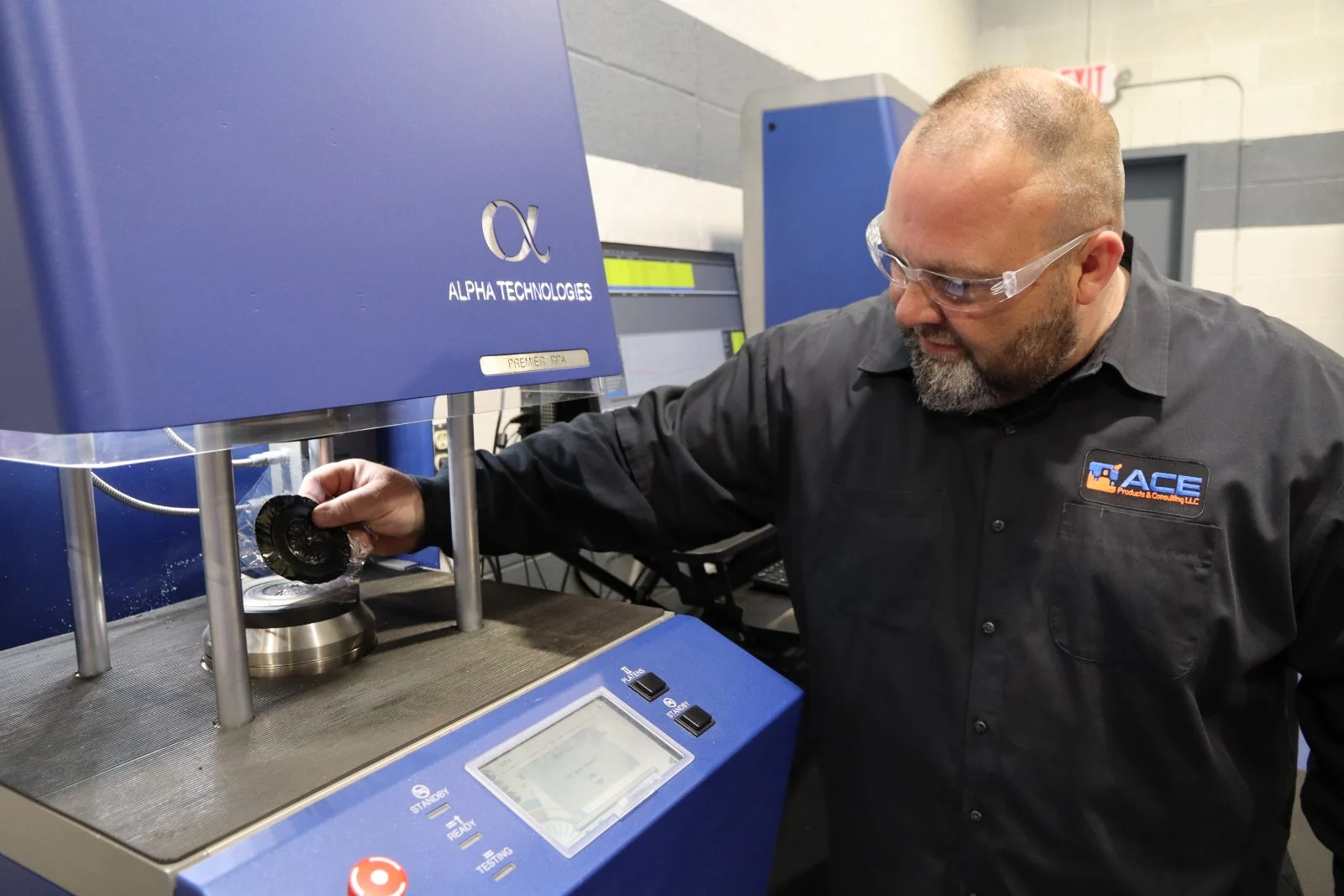Importance of Elastomer Processing
Elastomer processing testing can reveal valuable information about how a compound will behave in a mixing or manufacturing environment. Laboratory testing allows manufacturers to test, tweak, and optimize compounds and materials before they invest in large-scale production.
Manufacturers may invest in elastomer processing testing with a wide variety of goals in mind, including:
- Cost savings. Replacing one ingredient with a less expensive one can translate to massive savings at scale. Testing allows manufacturers to determine whether the more affordable ingredient will impact processability and experiment with changes to the recipe that can cut down the overall cost of ingredients.
- Time savings. Different cure systems and process aids can expedite the manufacturing process by improving processability, resulting in faster production. Manufacturers can test different options to determine the most efficient choice.
- Benchmarking. Processability is important to keep in mind during the research and development stage, as well as when making modifications to an existing recipe. If a manufacturer is choosing between multiple different ingredients or elements of a compound, they may invest in benchmarking testing, so they can make a confident decision using objective data.
- Sustainability. Businesses and consumers alike are prioritizing sustainability these days. Elastomer processing testing allows companies to test the performance of sustainable, alternative materials and improve the energy efficiency of production.
- Quality control. Elastomer processing testing can unveil potential quality issues in a controlled environment, giving manufacturers the opportunity to find and validate a solution before investing in large-scale production. Processability testing allows manufacturers to establish a quality reference against which they can benchmark future batches, a powerful strategy for ensuring long-term consistency quality control.
A testing laboratory can deploy a range of reliable processing tests in pursuit of any of these goals and more. Multiple test methods may be combined to develop a custom protocol, depending on the client’s needs and goals.
Rubber Processability Test Types
Thanks to a wide range of processing tests, manufacturers can gather significant data about the processability and processing performance of their materials in a laboratory environment. Investing in this testing up front ensures there are no costly surprises when production begins. Examples of processing and processability testing include:
Mixing Processability
For rubbers and elastomers, mixing processability generally refers to how the material responds to mixing or compounding. Compounding is a complex science, and the outcomes of a given compound are affected by a wide range of factors. Mixing processability testing is conducted on small batches of an experimental compound, so the recipe can be tweaked and validated on a more manageable scale before large-scale production occurs.
Milling/Calendaring
Rubber milling and calendering are similar rubber processing methods to produce continuous sheets of elastomer materials by running the materials repeatedly through a set of rollers. The material must be soft enough to be shaped without becoming too soft to hold together. Rubber milling and calendering tests are excellent for measuring and testing the different variables of these rubber processing methods, including:
- Shear force of the rollers.
- Number of passess needed to achieve the desired level of homogenization and viscosity.
- Thickness of the final sheet.
Molding
The purpose of molding testing is to test how a compound behaves when being made into a molded product. Testing allows the manufacturer to observe:
- Whether the material fills all cavities in the mold.
- Any areas of potential weakness or insufficient density on the final molded product.
- The rate and sequence of material flow throughout the mold, including any bottlenecks.
Manufacturers can use this information to make adjustments to both the compound and the mold and determine where to place entry points and gates to ensure optimum rubber processing. Both custom molds and industry standard spider molds can be used.
Extrusion Processability
Extrusion processability testing is an excellent way to test whether an extrusion compound achieves the appearance and contours intended in the original design. This type of testing also allows manufacturers to test whether they can achieve the same results with less expensive materials or different compounds.
A common test specification for extrusion processability is ASTM D2230—Standard Test Method for Rubber Property—Extrudability of Unvulcanized Compounds.
Other ASTM Tests for Rubber Processability
Other common test specifications for evaluating rubber processability include:
- ASTM D1646: Standard Test Methods for Rubber—Viscosity, Stress Relaxation, and Pre-Vulcanization Characteristics (Mooney Viscometer)
- ASTM D5289: Standard Test Method for Rubber Property—Vulcanization Using Rotorless Cure Meters
- ASTM D6204: Standard Test Method for Rubber—Measurement of Unvulcanized Rheological Properties Using Rotorless Shear Rheometers
- ASTM D6601: Standard Test Method for Rubber Properties—Measurement of Cure and After-Cure Dynamic Properties Using a Rotorless Shear Rheometer
- ASTM D3835: Standard Test Method for Determination of Properties of Polymeric Materials by Means of a Capillary Rheometer
- ASTM D7723: Standard Test Method for Rubber Property—Macro-Dispersion of Fillers in Compounds
- ASTM D8059: Standard Test Method for Rubber Compounds—Measurement of Unvulcanized Dynamic Strain Softening (Payne Effect) Using Sealed Cavity Rotorless Shear Rheometers
Rubber and Elastomer Testing Options From ACE Labs
ACE Laboratories has the in-house expertise and capabilities to conduct a wide range of rubber and elastomer processing tests, from the R&D stage to final validation before product launch. Our experts are well versed in both industry standard specifications and custom testing methodologies, so we can design a test protocol based around your specific goals and what you’re seeking to understand about the processability of your materials.
When you work with ACE, you entrust your testing to professionals with both industry and laboratory experience who bring a valuable perspective to your unique needs. You can count on ACE to help you choose your next steps with confidence. Plus, ACE is proud to offer the fastest turnaround times in the industry, so you can maintain your production timelines and stay on track.
To learn more about our rubber processing testing capabilities and get started on a project, talk to a member of our team >

